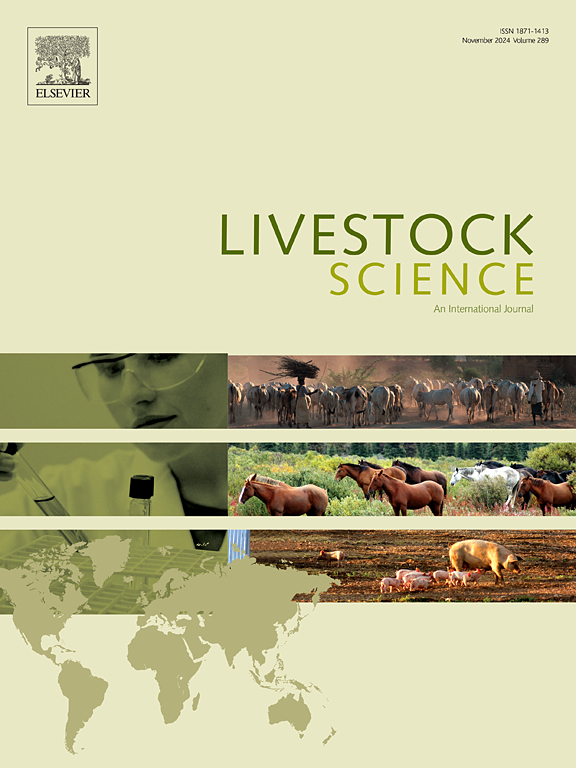手术阉割后仔猪注意偏向试验的应用
IF 1.8
3区 农林科学
Q2 AGRICULTURE, DAIRY & ANIMAL SCIENCE
引用次数: 0
摘要
公仔猪手术阉割是提高肉质的常规方法。先前的研究表明,阉割引起的疼痛可以持续长达4天,对动物福利产生负面影响,但对焦虑等情绪的影响尚不清楚。本研究的目的是测试一种新的注意偏倚测试的应用,以评估接受手术阉割的仔猪在有无实际疼痛缓解方法的情况下的焦虑。在3日龄时,分别对22头仔猪进行手术阉割、21头进行镇痛阉割和22头进行假手阉割。在第1周(n = 32, 10-11 /治疗)和第12周(n = 29, 9-10 /治疗)进行注意偏倚测试,评估焦虑(一种情感状态),同时出现饲料(积极刺激)、巨响和闪光灯(消极刺激)。在测试期间记录访问喂食器的潜伏期、行为反应和活动。在阉割后1、6和24小时三个时间点收集仔猪活动、尾巴和鬼脸的额外数据,以确定疼痛经历。第1周注意偏倚测试中,仔猪的活动增加(P = 0.065),访问喂食器的仔猪减少(P = 0.029),并且访问喂食器的潜伏期更长(P = 0.092),这可能表明手术去势引起的疼痛增加了焦虑。第12周无差异。去势治疗和采样时间点影响治疗后数小时的活动水平,但其他措施不受影响。这些结果表明,需要更多的研究来确定手术阉割引起的疼痛如何影响影响。活动和行为的结果在一定程度上支持先前的发现,即手术阉割导致仔猪疼痛。由于这是第一项评估疼痛手术与仔猪焦虑之间关系的研究,因此需要更多的研究来确定有效的方法来了解这些手术对猪情绪的影响。本文章由计算机程序翻译,如有差异,请以英文原文为准。
Application of an attention bias test after surgical castration in piglets
Surgical castration of male piglets is a routine procedure performed to improve meat quality. Prior studies have shown that pain due to castration can last for up to 4 days, negatively impacting animal welfare, however the impact on affect, such as anxiety, is unclear. The objective of this study was to test the application of a novel attention bias test to assess anxiety in piglets that underwent surgical castration with or without practical pain alleviation methods. Piglets were surgically castrated (n = 22), castrated with analgesics (n = 21), or sham-handled (n = 22) at 3 days of age. An attention bias test was performed in week 1 (n = 32, 10–11/treatment) and 12 (n = 29, 9–10/treatment) to assess anxiety (an affective state), with feed (positive stimulus), loud bangs, and flashing lights (negative stimuli) presented simultaneously. Latency to visit the feeder, behavioral responses, and activity were recorded during the test. Additional data on piglets’ activity, tails, and grimaces were collected at three timepoints, at 1, 6, and 24 h after castration to determine pain experience. Piglets’ increased activity (P = 0.065), the fact that fewer piglets visited the feeder (P = 0.029), and tended to have longer latencies to visit the feeder (P = 0.092) in the attention bias test in week 1 might suggest that pain caused by surgical castration increased anxiety. No differences were detected in week 12. Castration treatment and sampling timepoint impacted activity levels hours after treatments, however, other measures were not impacted. These results suggest that more research is needed to determine how affect is impacted by pain caused by surgical castration. Activity and behavioral results somewhat support previous findings that surgical castration causes pain in piglets. As this is the first study assessing the relationship between painful procedures and piglet anxiety, more research is needed to determine a valid method to understand the impacts of these procedures on pig affect.
求助全文
通过发布文献求助,成功后即可免费获取论文全文。
去求助
来源期刊

Livestock Science
农林科学-奶制品与动物科学
CiteScore
4.30
自引率
5.60%
发文量
237
审稿时长
3 months
期刊介绍:
Livestock Science promotes the sound development of the livestock sector by publishing original, peer-reviewed research and review articles covering all aspects of this broad field. The journal welcomes submissions on the avant-garde areas of animal genetics, breeding, growth, reproduction, nutrition, physiology, and behaviour in addition to genetic resources, welfare, ethics, health, management and production systems. The high-quality content of this journal reflects the truly international nature of this broad area of research.
 求助内容:
求助内容: 应助结果提醒方式:
应助结果提醒方式:


